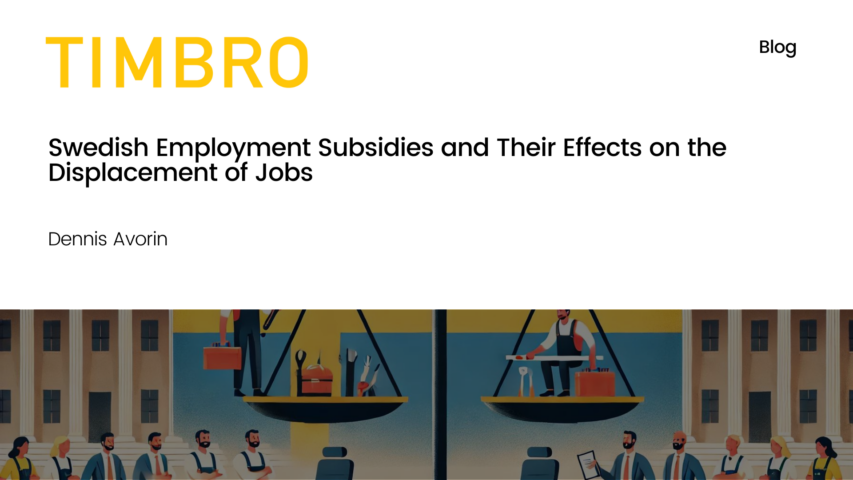Swedish Employment Subsidies and Their Effects on the Displacement of Jobs

Swedish Employment Subsidies and Their Effects on the Displacement of Jobs
Dennis Avorin // 6 September 2017
Since the refugee crisis of 2015, the Swedish government has made strong efforts to implement a particularly ineffective policy. Through so-called “public relief jobs”, a form of subsidised employment, the government has aimed to integrate newly arrived immigrants into the labour market. EPICENTER’s Swedish partner, Timbro, has recently published a report highlighting the flaws of such a system.
The “public relief programme” was first implemented in 2016, when the central government commissioned the Swedish Employment Agency, and called for the creation of 5,000 jobs by the end of 2020. This scheme was initiated despite research generally indicating that subsidised employment is not only the least effective, but also one of the most expensive, Active Labour Market Policies (ALMP). In 2017, the cost for subsidised employment in Sweden was estimated at 18.4 billion SEK (around 1.88 billion EUR). This figure equates to a 5% increase since the previous overview of subsidised employment, which was provided in 2014 by Almega, a service sector association.
Swedish welfare is often held up as the role model for successful ALMPs. It has, however, been demonstrated that many of the strategies adopted have had minor effects on unemployment. Indeed, employment subsidies seem to be among the worst forms of ALMPs. Hence, it is clear that Sweden’s low unemployment figures come in spite of, rather than as a result of, such programmes.
Today, the Swedish labour market makes use of twelve different forms of employment subsidies, which cover 3% of the entire active workforce. Previous research has demonstrated that although employment subsidies sometimes yield positive effects on an individual level, they can also result in the substantial displacement of real jobs and individual lock-in effects. Econometric studies indicate that the displacement effects are so pronounced that for every three subsidised jobs created, two regular jobs are displaced. International research further indicates that among developed economies Sweden’s utilisation of ALMP is particularly inefficient.
This compelling fact is found in a study by Card et al (2010), published in The Economic Journal. The authors analyse data from 97 different studies conducted between 1995 and 2007. Their sample contains 199 ALMP programme estimates from 26 different countries. The Nordic countries stand out as the country group with the highest percentage of ALMP spending on private and public employment subsidies. The results of their investigation demonstrate that subsidised employment is comparatively ineffective.
Graph 1 – Long-term effects of ALMPs by country group
The graph displays the estimated impact of ALMPs across the different country groups studied by Card et al. in the long-term (36 months after completion). The estimated positive impact in Nordic countries has been rather low – around 40%. It has hence been demonstrated that the tax money spent on such programmes has not yielded satisfactory long-term benefits.
In terms of long-term effects, the efforts that have been made in German-speaking countries have been the most successful, with 60.9% of programmes demonstrating significantly positive effects. These ALMP programs consist predominantly of classroom or work experience training. The Nordic countries, by contrast, have focused the least on classroom or work experience training, and the most on subsidised employment.
There is much to admire about the Swedish economic model. Its system of subsidised employment, however, has been shown to be deficient. The existing strategy of the Swedish government is in need of urgent re-evaluation. An alternative is to focus on market deregulation and lower business taxes. Public programmes, with the exception of those aiming at vulnerable groups such as people with disabilities, should be restricted to commercial vocational training programmes. This has the benefit of not displacing non-subsidised employment.
First and foremost, labour policies should aim to create jobs in the private sector. The bottom line is that subsidised public employment essentially is a tax-funded enterprise. Sweden needs to avoid the unnecessary expansion of its public sector with its subsequent tax increases and growing dependency ratio. The government must remember that this is ultimately paid for by the very private enterprises that are the only force able to create meaningful and real jobs, and help the unemployed to break free from their alienation.
EPICENTER publications and contributions from our member think tanks are designed to promote the discussion of economic issues and the role of markets in solving economic and social problems. As with all EPICENTER publications, the views expressed here are those of the author and not EPICENTER or its member think tanks (which have no corporate view).




